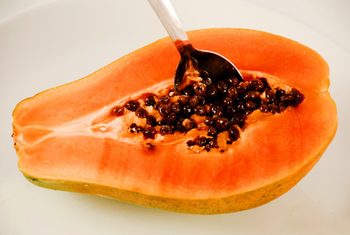Papaya - A Strange Name But Sweet Flavor
TEXARKANA, Ark. –
Papaya may be a fruit that you don’t traditionally add to your diet. It could be the strange name, or maybe the first one you tried was green and somewhat bitter in taste. Give them another try. Papaya is known for its rich sweet flavor, butter-yellow when fully ripe color, and pear like shape. Their pale-orange flesh has dozens of small, black, gelatinous seeds at the center, similar to a melon.
Where papaya comes from
The papaya is believed to be native to southern Mexico through the Andes of South America. It was spread to the south by the Indians and throughout the Caribbean through Spanish Exploration. In the 1800’s, papaya was introduced into Hawaii, and in the early 20th century it was introduced in Florida. However, the Florida crop experienced the introduction of a viral disease which destroyed the crop. This left Hawaii as the only state in the United States to produce papaya commercially today.
Types of papaya
There are two main types of papaya. The Hawaiian, usually known as Solo, is found most often in supermarkets. These papayas are pear shaped, weigh about one pound each, and have yellow skin when ripe. The flesh is bright orange or pinkish, depending on the variety, and contains small black seeds clustered in the center. They are somewhat reminiscent of black pepper, if eaten, and many times are used as an ingredient in salad dressing.
Mexican papayas, sometimes called Caribbean or Asian, are usually found in Latino supermarkets. Mexican papayas are much larger than the Hawaiian types and can weigh up to 10 pounds each and be over 15 inches long. The flesh of this variety might be yellow, orange, or pink. The flavor is less intense than the Hawaiian papaya, but is still delicious and extremely enjoyable.
Once cut, a ripened papaya will be juicy, sweet and similar to cantaloupe in flavor, although some types may be musky. It is most often consumed fresh as a breakfast or dessert fruit, but will also be used in a variety of products such as fruit juices, jams as dried fruit, or as a fruit salsa.
How to choose the best fruit
When shopping for a ripe papaya, look for skin that is turning from green to butter yellow. You should also be able to press your thumb slightly into the flesh. If it's too soft or mushy, or if it has a sweet smell to it, the papaya is overripe.
Slightly green papayas will ripen quickly at room temperature, especially if placed in a paper bag. As the papaya ripens, it will turn from green to butter yellow. Place ripe papayas in a plastic bag and store in the refrigerator. Papayas will keep for a week, but it is best to use them within a day or two.
Preparing papaya
To prepare your papaya, rinse under cool water to remove any dust or dirt. Place on a cutting board and use a large sharp knife to cut the papaya in half lengthwise. Separate into two sections.
Using a large spoon, carefully scrape out the seeds. Cut too deeply with your spoon and you can lose a lot of the fruit.
To peel a papaya, hold it vertically and run a knife downward along the skin in long slices, like you would if you were peeling a potato. Again, try not to slice too deeply.
Health benefits
Vitamin C is one of the strong points of papaya, providing 144 percent of the daily recommended value per serving, which is great as an infection fighter as well as a free radical-scavenging antioxidant. They are rich in vitamin A, vitamin E, carotenoids Lutein and zeaxanthin, and lycopene.
Papaya and Mango Spicy Salsa is a great accompaniment to meat such as fish or chicken and also great as a salsa served with pita or baked chips. Be cautious with the jalapeno peppers and do not rub your eyes during or after dicing.
For more information, contact the Miller County Extension Office, 870-779-3609 or visit us in room 215 at the Miller County Courthouse. We're online at chadley@uada.edu, on Facebook at UAEXMillerCountyFCS/CarlaHaleyHadley, on Twitter @MillerCountyFCS or on the web at uaex.uada.edu/Miller.
Papaya & Mango Spicy Salsa
- 1 cup ripe mango, peeled and cubed
- 1 cup papaya, peeled, seeded and cubed
- 1/2 cup onion, diced
- 1-2 cloves garlic, minced
- 1 fresh jalapeno pepper, seeded and diced
- 1/2 red bell pepper, diced
- 1/2 orange bell pepper, diced
- 1 lime, juiced
- salt and freshly ground black pepper to taste
Stir the mango, papaya, onion, garlic, jalapeno pepper, red bell pepper, orange bell pepper, lime juice, salt, and pepper together in a bowl. Enjoy immediately with baked pita or tortilla chips or cover bowl with plastic wrap and refrigerate until ready to use. The longer it sits in the refrigerator, the better the flavors will meld together.
By Carla Haley-Hadley
County Extension Agent - FCS
The Cooperative Extension Service
U of A System Division of Agriculture
